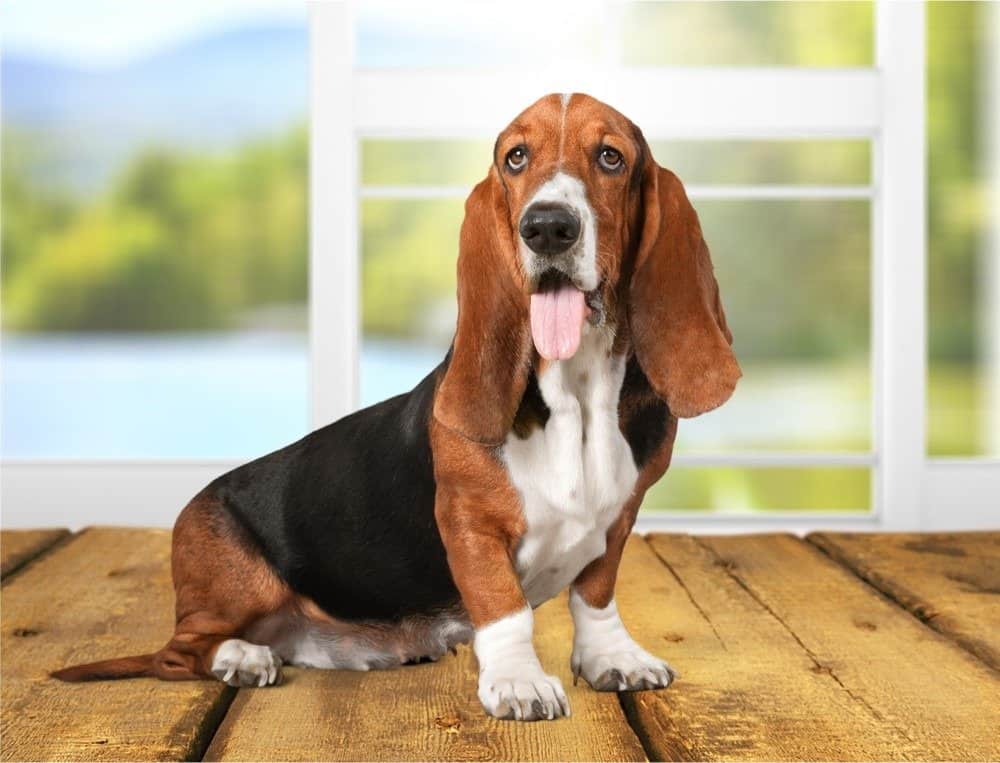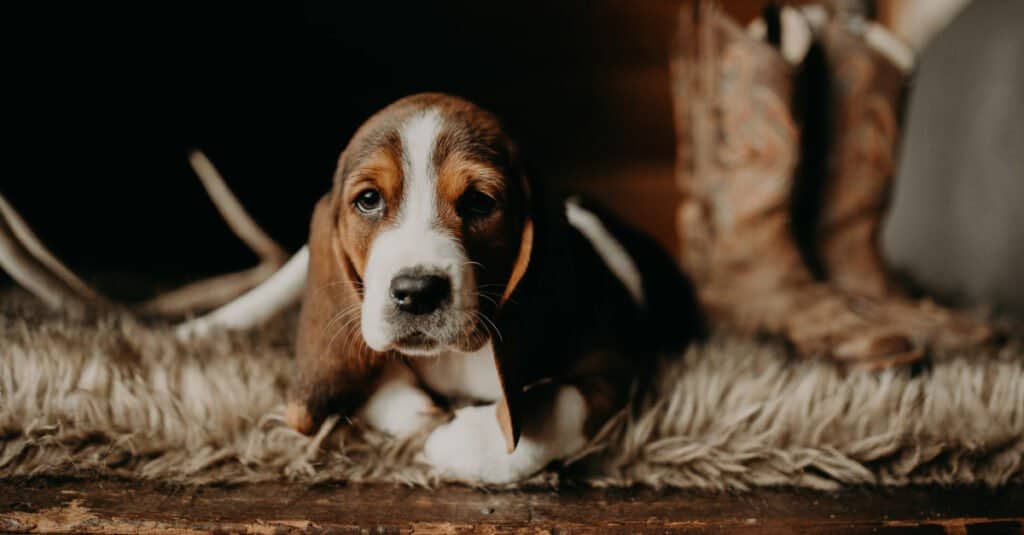When you have a Basset hound that is pregnant, it can be scary and exciting at the same time. We will look at a Basset hound pregnancy and what you can expect. These dogs are endearing and lovable and were bred for small game hunting, particularly rabbits. They are still used today for hunting all over the world. Additionally, they are affectionate, laid-back, and the ideal family dog. Furthermore, they are wonderful with kids and other dogs. Lastly, these dogs, with their low-set ears and distinctive bark, are superb companions.
Basset Hound Pregnancy Symptoms
Taking your dog to the vet is not the only way to confirm a pregnancy, although it is advised. Symptoms to watch out for include:
- Weight gain
- Swollen belly
- Increase in appetite
- Lethargy
- Increase in nipple size
- Irritability
- More affectionate
- Nesting behaviour
Due to changing hormones, some dogs may also have a decreased appetite and vomit for the first few weeks. However, the most accurate way of confirming a Basset hound pregnancy is by taking them to the vet.
Gestation Period: How Long Are Basset Hounds Pregnant?
Like most other breeds, Basset hounds are pregnant for about 63 days. Then whelping, or labor, can last up to 24 hours.
Pregnancy Care for Basset Hounds
Basset hounds are, unfortunately, prone to bloat. Therefore, it is recommended to divide their food while pregnant into four smaller meals per day instead of 2 large ones. Overfeeding is a big no-no because if a dog is overweight, it could lead to delivery complications.

Basset hounds are, unfortunately, prone to bloat. Therefore, it is recommended to divide their food while pregnant into four smaller meals per day instead of 2 large ones.
©Billion Photos/Shutterstock.com
Average Litter Size for Basset Hounds
This breed’s litter size, on average, is eight puppies. However, some Basset hounds have litters of up to 15 puppies.
What to Expect in Week 1
After the female and male Basset hounds mate, many eggs fertilize within the uterus. After that, the eggs will move to the uterine horns. The female Basset hound will experience hormone fluctuations within the first week. However, this is internal, and the owner will not notice any changes externally. In the first week, if you know your Basset is expecting, you should continue your regular routine where activity and food are concerned.
What to Expect in Week 2
In week 2, grooming can continue as normal as the dog’s embryos are well protected in the uterus. Also, there is no need to change your dog’s diet as yet. The goal for this week is to maintain the basset’s weight. This is because early weight gain is not advised for a healthy pregnancy. It is recommended that the dog gain at most 10% of its usual weight until it reaches the 8-week mark. Also, the female’s energy levels should not be affected yet because the embryos have not grown too much.
What to Expect in Week 3
Week 3 will still not bring much physical transformation, and there is still no need to change your dog’s routine. However, the basset may have a bigger appetite. Therefore, owners may begin to increase the amount of food, adding small amounts. By week 3, the puppies are protected in a membrane that provides them with the necessary nutrients.
What to Expect in Week 4
When your Basset hound reaches 25 days or three weeks, it is recommended to take them to the vet for a check-up. The vet will likely perform an ultrasound to ascertain how big the litter is, the mother’s health, and the birth date. Additionally, the vet will be able to see if there are any health concerns or pregnancy complications.
What to Expect in Week 5
Week 5 is when the puppies have completed the embryogenesis phase of the Basset hound’s pregnancy. Also, the embryo is now called a fetus because the organs start developing. At this stage, the female will begin to gain weight. It is recommended to feed the mother more food; the vet will be able to advise on quantities.
What to Expect in Week 6
The puppies develop distinct organs, cells, and claws at this stage. In week 6, the mother will need a diet with more minerals, healthy protein, and higher energy ingredients. However, she might have a decreased appetite due to discomfort during pregnancy. To help alleviate this, she should be offered smaller meals more frequently, as she must eat correctly during the gestation period.
What to Expect in Week 7
In week 7, you can expect more or less the same as week 6. It is vital to keep the mom comfortable and eating correctly.
What to Expect in Week 8
Week 8 will continue in the same vein as weeks 6 and 7. Mom will begin to get more uncomfortable. Also, she might have a decreased appetite due to being uncomfortable.
What to Expect in Week 9
The final week sees the puppies almost fully developed. Mom might be nesting, looking for a place to give birth. Also, you will notice her nipples getting more prominent, and they may even discharge some milky fluid. At this stage, the mother will be quite large, and you may even be able to see or feel the puppies moving around.
How to Prepare for Labor and Delivery
Preparing for labor and delivery starts with setting up a whelping box for your Basset hound. These can even be bought and provide a warm, safe, and clean place for your basset to give birth. This box should be placed in a quiet area and easily accessible for mom to get in and out of. The mother must be introduced to the box beforehand to become accustomed to it. First-time breeders should ask their vet how to assist in this process.
Some items that may come in handy during labor include newspaper, dry and clean towels, paper towels, a thermometer, clean and sterilized scissors, iodine, a heat lamp, a baby scale, and a vet’s phone number in case of an emergency. A few days before the birth, the mother may stop eating and start trying to build a “nest” to give birth in. Also, when it gets close to delivery, many dogs will begin to pant, and their rectal temperature drops around 8 to 24 hours before giving birth. The water sac usually comes out an hour before the first puppy is born.
How to Care For Your Basset Hound Afterward
After the mother has given birth, it is crucial to supervise her all the time for the first two to three weeks, as Basset hounds are known to lie on their puppies and suffocate them. Also, it is advised always to keep the mom clean and dry. It is normal for her to leak after birth. She should be wiped down with a warm, damp cloth but not bathed, as you don’t want the new pups to encounter soap residue. Also, her teats need to be checked regularly, and if you notice any swelling, discoloration, or redness, you should get her to the vet. Mom will be exhausted after giving birth; she will need plenty of clean drinking water to rehydrate and produce milk for her pups.
Additionally, a lactating dog will need proper nutrition. Ensure to feed her top-quality food, as she needs as many nutrients as possible. Again, she will require smaller portions more often. Lastly, the mother will initially be very protective of her puppies and may not want to leave them. However, it is important that she takes short 5 to 10-minute breaks to relieve herself. Mother Bassets are more than capable of caring for their puppies, but owners should continue to monitor her and the puppies closely for the first few weeks.

After the mother has given birth, it is crucial to supervise her all the time for the first two to three weeks, as Basset hounds are known to lie on their puppies and suffocate them.
©iStock.com/Jessica Nystrom
The photo featured at the top of this post is © Seregraff/Shutterstock.com
Ready to discover the top 10 cutest dog breeds in the entire world?
How about the fastest dogs, the largest dogs and those that are -- quite frankly -- just the kindest dogs on the planet? Each day, AZ Animals sends out lists just like this to our thousands of email subscribers. And the best part? It's FREE. Join today by entering your email below.
Thank you for reading! Have some feedback for us? Contact the AZ Animals editorial team.







